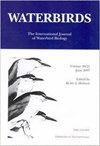缅因湾筑巢群燕鸥雏鸟饮食的种间和地方差异
IF 0.6
4区 生物学
Q3 ORNITHOLOGY
引用次数: 1
摘要
摘要美国缅因湾是四种共同筑巢燕鸥的栖息地:最小燕鸥(Sternula antillarum),普通燕鸥(Sterna hirundo),北极燕鸥(Sterna paradisaea)和联邦濒危的玫瑰燕鸥(Sterna dougallii)。为了在该地区进行一项比较饮食研究,收集了30多年来对雏鸡喂养的视觉观察,包括首次详细描述最小燕鸥和玫瑰燕鸥雏鸡的饮食。在1986-2017年期间,燕鸥物种中有三个猎物群构成了大部分的雏鸡饮食:鳕(Urophycis spp.或Enchelyopus cimbrius)的出现频率为28-37%,沙鲈(Ammodytes americanus或A. dubius)的出现频率为8-22%,鲱鱼(Clupea spp.或Alosa spp.)的出现频率为3-30%。不同物种和岛屿的饮食贡献各不相同。在两个近海栖息地,普通燕鸥饮食中含有较多的沙枪(30-42%),而近海岛屿含有较少的沙枪(5-9%)。一般燕鸥(H′= 1.57)和北极燕鸥(H′= 1.74)的总体膳食多样性(H′)相似,而以食鱼为主的玫瑰燕鸥(H′= 1.24)和北极燕鸥(H′= 1.37)的总体膳食多样性(H′= 1.37)较低。基线膳食信息提供的膳食可塑性程度和一般饲养生态可以为全面评估当前和未来渔业和气候变化干扰的风险提供信息。本文章由计算机程序翻译,如有差异,请以英文原文为准。
Interspecific and Local Variation in Tern Chick Diets Across Nesting Colonies in the Gulf of Maine
Abstract. The Gulf of Maine, USA is home to four colonial co-nesting tern species: Least Tern (Sternula antillarum), Common Tern (Sterna hirundo), Arctic Tern (Sterna paradisaea), and the federally endangered Roseate Tern (Sterna dougallii). Over three decades of visual observations of chick provisioning were compiled for a comparative dietary study in the region, including the first detailed descriptions of Least and Roseate Tern chick diets. Three prey groups comprised the majority of chick diets among tern species between 1986–2017: hake (Urophycis spp. or Enchelyopus cimbrius) 28–37% frequency of occurrence (FO), sand lance (Ammodytes americanus or A. dubius) 8–22% FO, and herring (Clupea spp. or Alosa spp.) 3–30% FO. Dietary contributions varied across species and islands. At two inshore colonies, Common Tern diets contained higher amounts of sand lance (30–42% FO), while offshore islands contained lesser amounts (5–9% FO). Overall dietary diversity (H′) was similar between Common (H′ = 1.57) and Arctic Terns (H′ = 1.74) and notably lower in Roseate (H′ = 1.24) and Least Terns (H′ = 1.37), whose diets were primarily piscivorous. The degree of dietary plasticity and general feeding ecology provided by baseline dietary information can inform holistic assessments of risk to ongoing and future disturbances from fishing and climate change.
求助全文
通过发布文献求助,成功后即可免费获取论文全文。
去求助
来源期刊

Waterbirds
生物-鸟类学
CiteScore
1.30
自引率
0.00%
发文量
0
审稿时长
6-12 weeks
期刊介绍:
Waterbirds is an international scientific journal of the Waterbird Society. The journal is published four times a year (March, June, September and December) and specializes in the biology, abundance, ecology, management and conservation of all waterbird species living in marine, estuarine and freshwater habitats. Waterbirds welcomes submission of scientific articles and notes containing the results of original studies worldwide, unsolicited critical commentary and reviews of appropriate topics.
 求助内容:
求助内容: 应助结果提醒方式:
应助结果提醒方式:


